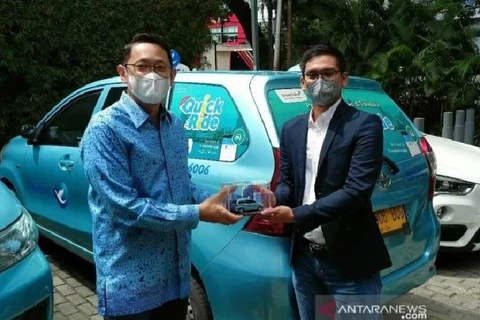 Traditional taxis need to introduce new innovations to regain their popularity among locals. (Photo courtesy of nld.com.vn)
Traditional taxis need to introduce new innovations to regain their popularity among locals. (Photo courtesy of nld.com.vn) However, with the COVID-19 pandemic and the recent increase in the price of gasoline, many people have re-opted for traditional taxis because it is increasingly difficult to book ride-share cars, and the fares have risen sharply.
It took less than 100,000 VND for a traditional taxi to travel from Tan Binh district to District 1 during rush hour while that of ride-hailing cars was 200,000 VND, Binh, a resident of Tan Binh district, told Nguoi Lao Dong (Labourer) newspaper.
It is worth mentioning that Binh booked his trip via multiple ride-hailing apps and was still not able to call for any taxis.
Le Minh Hieu, who is living in Binh Thanh district, shared a similar concern and has switched to motorbike taxis or traditional taxis because the price is more stable and it is easier to book a trip.
"Many people still believe that the fares for ride-hailing cars are lower than taxis and motorbike taxis, but the reality is completely different. In addition to 10,000 VND per kilometre, there are extra fees for each ride, which passengers have to pay for. During peak hours or under rainy weather, the price jumps up to two to three times but drivers still cancel the booking without ride-hailing app users understanding why,” Hieu said.
Flexible pricing and no extra fees are traditional taxis’ advantages, Chu Hau, a resident of Thu Duc city, said.
“Traditional taxis are just one call away and some companies have created a booking app to make it easier for passengers to call for cars,” he added.
These days, more and more ride-hailing car drivers have turned off the app and stopped working due to the high price of petrol and the increasing percentage of revenue ride-hailing apps take.
The more they drive, the more they lose.
Tran Van Toan, who is living in District 8, said that he has recently switched from being a GrabCar to traditional taxi driver.
“GrabCar drivers cannot earn much due to the 30% commission while traditional taxi drivers only need to pay 6-7% of their revenue to the company,” he said.
Khuat Van Tung in Tan Binh district, who is a former ride-hailing taxi driver, said that he recently applied for Vinasun, a traditional taxi company.
Tung is given a company car and revenue is split 50/50 while all expenses are paid by the company.
“If you can earn more than 2 million VND, the driver will enjoy 90% of the revenue over 2 million VND,” he added.
Innovation
Le Trung Tinh, chairman of the HCM City Passenger Car Transport Association, said that ride-hailing companies initially tried their best to take care of customers with a series of incentives, cheap fares, discounts, and free extra trips.
After dominating the market, they started to impose all kinds of fees and increase the price.
Recently, Grab has introduced new surcharges in hot weather, which has caused dissatisfaction among consumers, especially given the context of the pandemic and economic difficulties.
This can be an opportunity for taxi companies to strengthen their fleet of vehicles and regain their image, thereby regaining the balance of two types of urban transportation and helping to reduce the growth in number of private vehicles and traffic congestion.
According to Doan Hong Duc, head of Traffic Planning Department of the HCM City University of Transport, traditional taxis and ride-hailing vehicles are currently both integral parts of the multilateral transport system in cities around the world and in Vietnam.
Though traditional taxis have been more embraced, some shortcomings need to be overcome in order to gain the trust of consumers.
It is crucial for traditional taxi companies to use well-trained and experienced human resources and apply new technology to offer reasonable prices to attract customers and compete with ride-hailing car companies, experts said./.
VNA






















